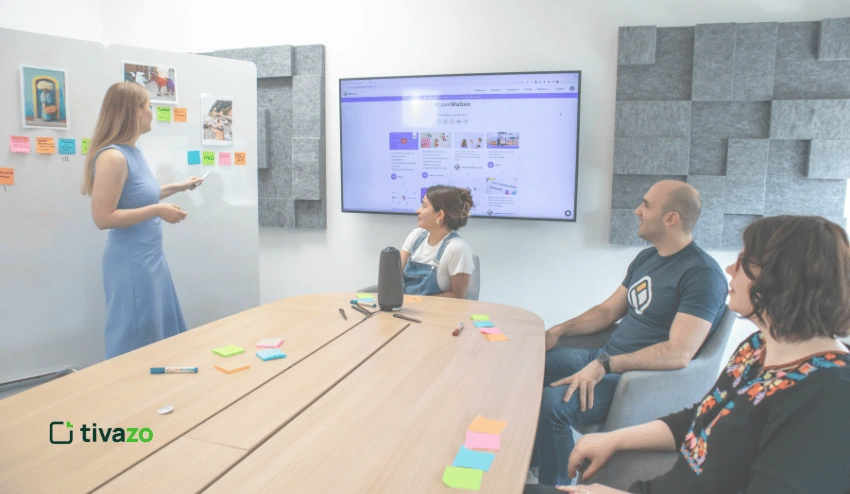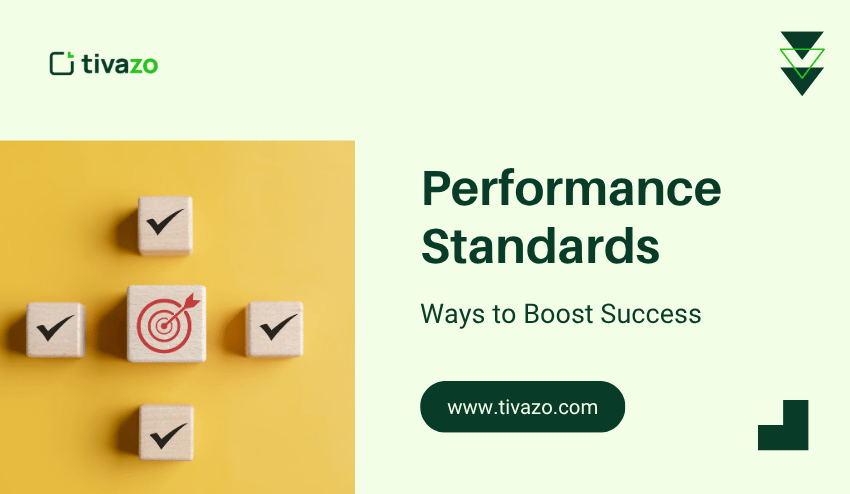In today’s fast-moving world, it is common to manage several tasks at the same time. It is natural for people to shift their focus continuously, but this can negatively impact focus, productivity, and well-being. When you focus on one task at a time – also known as single-tasking – you will have smarter, less stressful, and better work. In the following guide, we will look deeper into single-tasking – why it works, the benefits, and practical strategies to apply it.
Single-Tasking: The Key to Focus and Productivity
In today’s fast-moving world, it is common to manage several tasks at the same time. It is natural for people to shift their focus continuously, but this can negatively impact focus, productivity, and well-being. When you focus on one task at a time – also known as single-tasking – you will have smarter, less stressful, and better work. In the following guide, we will look deeper into single-tasking – why it works, the benefits, and practical strategies to apply it.
While simple, single-tasking is powerful and has become a “game changer” when working to be productive. Working one task at a time allows you to focus all your attention on that single task, permitting your brain to work more effectively; to think deeper, rationally, and to think critically; and your quality of work will improve too. In contrast, multitasking divides your attention – and slows down your overall progress. Single-tasking will allow you to wrap up your work more quickly and with less mental fatigue.
And, more than just productivity, doing one task at a time has other benefits too; while your focus improves, your mindfulness will increase your self-satisfaction, bring better composure and calmness, and control over your day. Whether in your work, study, or a personal project you are managing, learning to work one task at a time can shift how you feel about yourself, your work, and your overall life, too.
In this blog, we will talk about what it means to work one task at a time, why multitasking fails, and practical suggestions you can use in daily life to increase efficiency (and well) – work-wise.
What is meant by one task at a time?
One task at a time means directing all our attention and energy toward one activity until it’s finished (or until we have made substantial progress). Unlike multitasking, where our attention is divided between multiple things, one task at a time is about giving our complete focus and attention to the present task.
When you do one task at a time, your brain can process information in a more focused and effective manner, decreasing error and improving productivity quality. So why is this important?
- Better Focus: Your brain will be much more engaged, and there will be more opportunities for problem-solving and creativity.
- Better Accuracy: The more distractions you have, the more mistakes you are going to make and the more things you will have to redo.
- Faster Time: Generally, when you finish one task at a time, you will be done faster than if you are constantly switching things up.
- Reduced Stress: Working on one task at a time will lessen the total mental stress associated with too many tasks at once.
- More Satisfaction: You will find that you get a real sense of accomplishment by finishing one task, and therefore, you start with more motivation to continue with the next.
Embracing the one task at a time mentality will provide greater value, production, and fulfillment with your work.
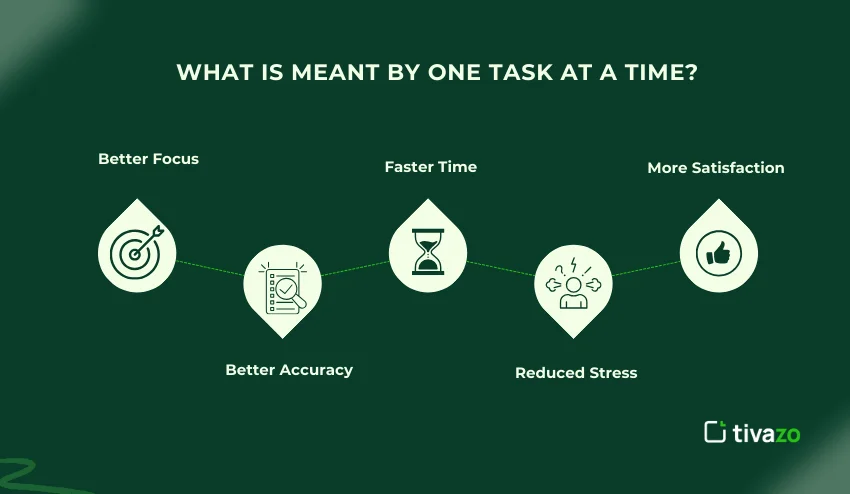
What Is It Called When You Do Only One Thing at a Time?
Doing one thing at a time is most commonly referred to as:
- Single-tasking
- Monotasking
- Deep work (a term made popular by productivity gurus).
They all express the idea of giving one task your attention rather than dividing attention among several tasks. When you simply focus on one task at a time, you are teaching your brain to be attentive and alert to each task, therefore tapping into your full level of efficiency and effectiveness. Practicing to do one thing at a time, consistently, will change the way you work and make every task more productive and less stressful, while maximizing focus and output.
One Task at a Time Example
Examples of doing one task at a time are:
- You write an article without checking social media.
- You attend a meeting without responding to an email.
- You read a book without watching TV at the same time.
- You make dinner without scrolling through your phone.
All the examples illustrate how eliminating distractions can lead to concentrated attention to your task and a better level of quality. Practicing on task at a time allows your brain to fully concentrate on what is important rather than dividing its attention between various tabs of activity.
- More examples of one task at a time in everyday life include:
- Exercise without checking your phone or thinking about the next task.
- Respond to emails in dedicated time slots instead of constantly switching between tasks.
- Studying or learning a new skill without divided attention would lead to better retention.
The experience of committing to one task at a time will alleviate errors, increase productivity, and create a sense of accomplishment. Over time, this practice will increase productivity, decrease stress, and strengthen your ability to engage deeply in important activities.
Why Multitasking Doesn’t Work
Most people think they are saving time by multitasking. However, research shows this is not the case. When you try to do multiple things at once, your brain cannot maintain full focus on any one task, which leads to inefficiency and increases the number of mistakes you will make. Focusing on one item at a time allows your mind to work more deeply and therefore produce a better quality of work.
Here is a direct comparison.
| Multitasking | One Thing at a Time |
| Splits Attention / Decreases Focus | Able to Increase Concentration and Mental Clarity |
| More Mistakes, More Rework | Able to produce better quality of work |
| More Stress and Mental Fatigue | Reduction of stress since tasks can be done simply |
| Decreases Productivity by Task Switching | Easily completes with greater focus and more quality work |
To summarize, multitasking leads you to trick your brain into thinking you are being productive; however, you are wasting just as much energy and time now catching up and switching back to each different task. You will find that practicing doing one task at a time will increase efficiency and reduce mental fatigue, and also ensure each task is performed correctly. Committing to doing one task at a time helps you regain control, concentrate on each task, and produce something meaningful without the extra stress of multitasking.
Benefits of Single-Tasking
When you focus on just one task, there are multiple benefits:
- Greater focus – Your brain is focused on the task, so your focus and efficiency can improve.
- Higher quality – Without distractions, there will be fewer mistakes, and your outcomes will be more accurate.
- Faster productivity – You will finish individual tasks more quickly, without switching costs.
- Less stress – You feel more at ease and in charge of your energy, rather than spreading your attention.
- Improved memory – You remember better as your brain has a higher capacity to process information more fully.
- Increased discipline – You develop consistency and self-control, so you are capable of engaging in more challenging work.
- Increased satisfaction – You get to finish every task, one at a time, which builds motivation and satisfaction.
When you practice working on one task and take advantage of these benefits, you not only increase productivity but also mental clarity, memory, decision-making, and overall well-being. When you make single-tasking a habit, this can completely change your life, whether it be work or personal.
How to Maintain Focus on Individual Tasks
In a world full of distractions, it can be especially difficult to focus on one task at a time. Here are some strategies you can implement:
1. Pomodoro Technique
Work on a single task at a time for 25 minutes, then take a 5-minute break. Repeating this over and over is a good way to remain concentrated on your task, while also preventing fatigue.
2. To-Do Lists
List out all your tasks in order of importance before beginning, and then tackle them one at a time instead of trying to work on too many at once. Having a comprehensive view will ensure one task receives your complete attention.
3. Eliminate Digital Distractions
Turn off notifications on your devices, close unneeded tabs and applications, and set up an environment where it is easy to focus on one task instead of the multitude of tasks battling for attention.
4. Mindfulness
Take a minute before beginning to simply stop and breathe. Mindfulness is the practice of training your brain to be present in the activity you are doing. Mindfulness will improve both efficiency and satisfaction. It also helps to engrave the habit of concentrating on one task at a time.
5. Time Blocking
Consider committing to time blocks in your calendar to make time for behaviours for greater deep work. Make blocks specifically for one task at a time to maximize productivity.
6. Be Clear About What “Done” Is
Be certain when you start and define what “done” looks like for each task you are doing. Having clarity helps maintain focus and will lessen what I call “task juicy” temptation of multitasking.
Over time, each one of these strategies will enhance the habit of putting your efforts into one task at a time, ultimately enhancing productivity.
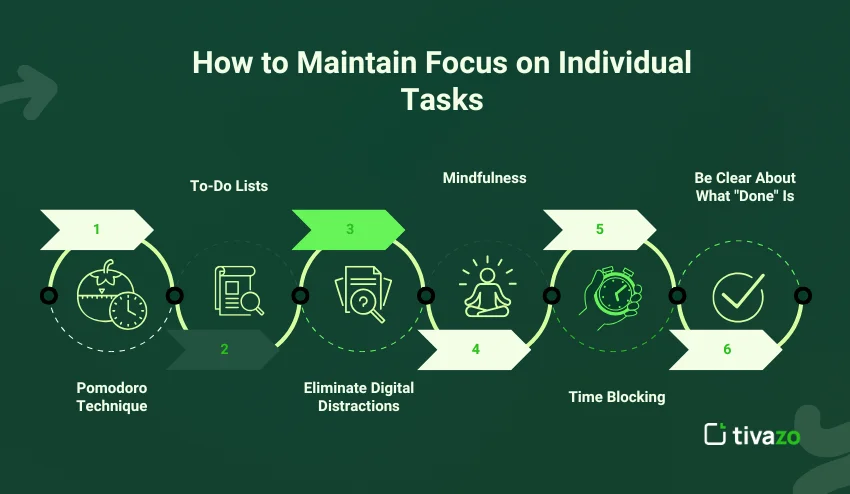
Single Tasking vs Multitasking
Let’s take a look at the two styles:
| Factor | Single Tasking (One Task at a Time) | Multitasking |
| Productivity | High | Low |
| Stress Levels | Low | High |
| Depth of Focus | Deep | Scattered |
| Quality of Work | High | Low |
| Completion Speed | Faster Over all | Not as fast due to context switching |
Conclusion: There is no competition; single-tasking is more efficient and beneficial in the long run.
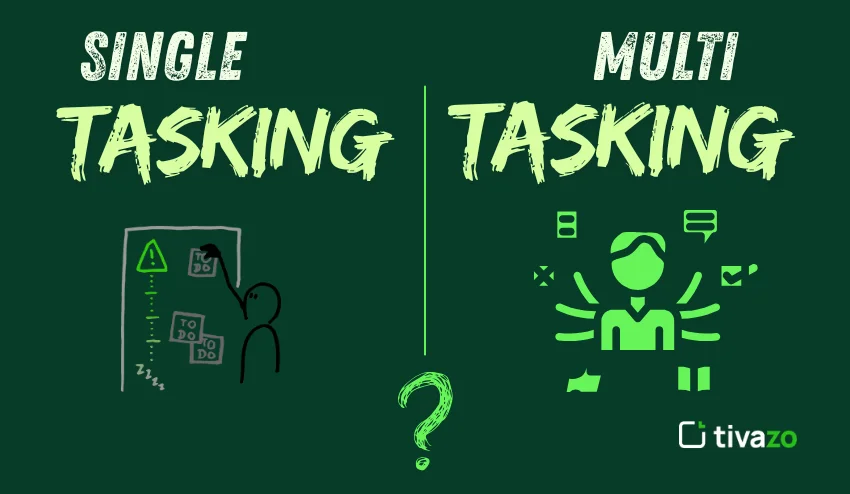
Four Ways to Make Single Tasking Work for You
Here are some easy, actionable strategies that will help you stick to one task at a time:
- Break tasks into manageable steps – Smaller steps make it easier to stay focused on what you are doing.
- Set clear goals – Be sure you know what “done” looks like.
- Batch similar tasks together – Reduce the time and energy switching between tasks; emails, calls, or reports are all tasks that can be grouped and completed as one task.
- Keep track of your progress – There are many apps, or you can keep a journal to track how often you are working on one task at a time.
- Reward yourself – Use it as motivation after completing a task.
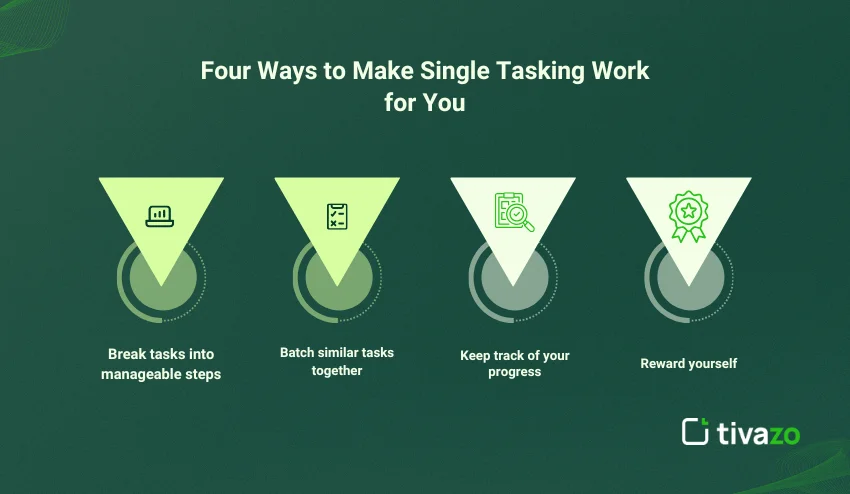
The Importance of One Task at a Time for Teams
From the organizational perspective, using one task at a time can:
- Reducing employee burnout.
- Enhancing team performance.
- Improve the focus and discipline culture.
- Deliver projects faster with fewer mistakes
When the team uses one task at a time, productivity tends to increase, communication is clearer, and morale improves overall layers of employees. When we encourage employees to work on only one task at a time, we are ensuring that it is done as effectively and accurately as possible while reducing mistakes and stress. Over a prolonged period of time, working one task at a time builds a more engaged, disciplined, and effective (high-performing) team that can sustain results.
Conclusion
In our fast-paced world, it can be very tempting to multitask. However, real productivity comes from focusing on one thing at a time. When you master single-tasking, you will achieve better outcomes, greater well-being, and feel a greater sense of control over your work and your life.
Instead of diffusing energy, focus it. Instead of hurrying, concentrate. Instead of multitasking, single-task…and achieve more with less stress.


